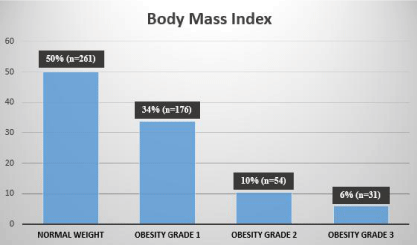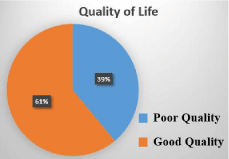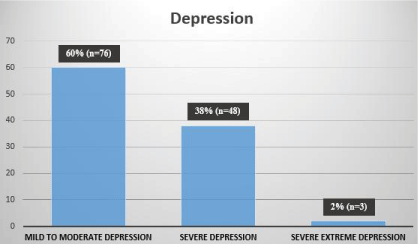Abstract
Background: Obesity is defined as abnormal or excessive accumulation of fat that represents a risk to health. Obesity affects the quality of life, increases mortality and has a high economic cost. It is associated with psychiatric disorders such as depression and anxiety.
Aim: The purpose of this study is to determine the association between obesity, depression and quality of life in Tijuana, Mexico.
Design and Setting: Comparative cross-sectional study.
Methods: In 522 patients in the Family Medicine Unit #27, Tijuana, Baja California, depression, quality of life and body mass index were measured to make an association between them. The following variables were collected: age, sex, body mass index, depression, quality of life and obesity. For statistical analysis, association was established with odds ratio and chi-squared test with 95% interval confidence (p<0.05).
Results: The association between obesity and quality of life (functional and mental) showed the following results: obesity and QOL (functional) [OR=2.9, 95% CI (2.0-4.2), p <0.001], obesity and QOL (mental) [OR=4.0, 95% CI (2.7- 5.9), p <0.001]; the association between obesity and depression showed the following result: [OR=3.8, 95% CI (2.4-6.0), p <0.001]; both associations had statistically significant differences.
Conclusion: There is a relationship between obesity, depression and quality of life, showing a higher percentage than that found in the literature.
Keywords: Obesity; Depression; Quality of Life
Introduction
Obesity is considered a multifactorial metabolic disease, which is determined by social, physiological, metabolic, molecular and genetic elements [1]. Obesity represents a public health problem due to its high prevalence, mainly affects young adults and causes a decrease in hope and quality of life [2]. The natural history of chronic diseases is the result of the union of genetic factors, sedentary life and a diet with excess calories, saturated fats and simple sugars, which progressively generates accelerated weight gain in the individual. Obesity reduces the life expectancy of people and is associated with a lower quality of life. In recent years the factors involved that allow the expansion of this epidemic are changes in eating habits and decreased physical exercise [3].
In Mexico, the distribution by States indicates that there is greater frequency in Colima, Baja California, Baja California Sur, Nuevo Leon, Tamaulipas, Yucatan, Jalisco, Sonora and Sinaloa, with percentages of overweight and obesity greater than 35% of the general population. Only seven States have frequencies below 25%, Hidalgo, Tlaxcala, Guerrero, Michoacán, Oaxaca, Tabasco and Chiapas; in the rest of the States there is a frequency between 25 and 35% [4]. In Mexico, the prevalence of overweight is higher in men than in women, while the prevalence of obesity is higher in women than in men [5]. In Europe, men outnumber women in obesity and overweight [6].
It has been shown that the relationship between socioeconomic conditions and obesity may vary according to income, sex and age. It is recommended to prescribe a healthy diet and regular physical activity as a first line treatment to achieve the reduction of overweight or obesity. Programs for weight loss and maintenance in overweight and obese patients should include interventions in physical activity, changes in diet and behavior modification [7]. Due to society's concern for thinness and importance to body shape, people with obesity feel a great social pressure that produces rejection, deterioration of social relationships, non-acceptance of body image, low self-esteem , personality disorders and mood disorders such as: depression, anxiety and eating disorders, which affects their psychological health, their well-being and therefore their quality of life [8].
Beyond the medical consequences, there are psychosocial and behavioral alterations, highlighting body dissatisfaction linked to overweight and obesity, which has a direct relationship between greater weight and greater dissatisfaction [9]. Among the behaviors of excessive feeding, the DSM-V describes: binge eating disorder, anxiety and depression, which is a common mental disorder with a prevalence of 5-10% in the developed world and which seems to be increasing [10-11], it is estimated that up to 66% of patients have had a depressive disorder at some time in their life [12]. Based on the above, the main objective of this research is to determine the association between obesity, depression and quality of life in Tijuana, Mexico.
Materials and Methods
A comparative cross-sectional study was carried out in the Family Medicine Unit #27 (FMU-27), of the Instituto Mexicano del Seguro Social (IMSS), located in Tijuana, Baja California, Mexico, in adults that met the following inclusion criteria: age between 18-59 years, that accepted and signed the informed consent; adults with psychiatric illness or pregnant women were not included and eliminated those who did not complete the survey.
The following data were obtained directly from the participants or medical records: age, sex, body mass index (BMI), obesity, quality of life and depression. The procedure for the data collection was as follows: age was calculated in years according to the year of birth, sex was determined according to phenotypic characteristics of each patient, BMI was calculated with the Quetelet index (weight/height2), obesity was defined as a BMI =30 kg/m2, the quality of life (QOL) was evaluated with the SF-12 health questionnaire, which has 12 questions on a Likert scale, which guides us to the patient's health status, the score ranges from 0-100, the cut-off point is 50, a score higher than 50 is considered good quality of life and a value less than 50 points is considered as poor quality of life, a value close to 100 indicates better quality of life. For depression, we used the Beck Depression Inventory (BDI), this test was standardized by Jurado (1998) in the Mexican population (a= 0.89-0.92), it is a questionnaire consisting of 21 questions, with 4 probable answers that are scored from 0-3 (a= 0, b= 1, c= 2 and d= 3). The symptom severity scores range from 0-63, where 63 represents the maximum severity. The cutoff point established by Jurado for Mexican population was 10 points. The accepted ranges are: 0-9 normal, 10-18 indicates mild to moderate depression and =30 indicates extremely severe depression.
The recollected data was integrated into data collection sheets and analyzed using the SPSS program version 20 in Spanish, where we applied descriptive statistics; for qualitative variables, frequencies and percentages were used and for quantitative variables, mean and standard deviation were used. For the bivariate analysis, odds ratio and Ji-Square test was used to determinate association and statistically significant differences between the groups. The Kolmogorov-Smirnoff test was used to establish the normality of the data. It was considered a p<0.05 as statistically significant, with a 95% confidence interval. The Protocol was authorized by the Local Committee of Research and Ethics in Health Research from the Family Medicine Unit #27, where this study took place.
Results
We analyzed a sample of 522 patients, the age distribution was from 18 to 59 years, with a mean of 39.9 ± 11.4 years. In sex, there was an equality distribution with 50% (n=261) men and 50% (n=261) women. In BMI (Graphic 1) there were 261 (50%) participants with normal weight and 261 (50%) with obesity, of which 176 had obesity grade I (33.7%), 54 obesity grade II (10.3%) and 31 obesity grade III (5.9%). Of the total of surveys conducted, 127 (24.3%) patients were found to have a positive result for some degree of depression, in this group, 59.84% had mild to moderate depression, 37.79% had severe depression and 2.36% severe extreme depression (Graphic 2). It is important to mention that Beck's inventory only evaluates depression data in patients so it does not make a definitive diagnosis. In quality of life, the prevalence of poor or good quality of life was calculated based on two categories, functional and mental (Graphic 3 & 4), within the functional category the participants had a higher frequency of poor quality of life (58.8%), in the category mental, most participants had good quality of life (61.5%).

Figure 1: Descriptive analysis of the distribution by BMI.

Figure 2: Descriptive analysis of the distribution by quality of life (Functional).

Figure 3: Descriptive analysis of the distribution by quality of life (mental).

Figure 4: Descriptive analysis of the distribution by depression.
For bivariate analysis we make an association between obesity, quality of life and depression (Table 1); the association between obesity and quality of life (functional and mental) showed the following results: obesity and QOL (functional) [OR=2.9, 95% CI (2.0-4.2), p <0.001], obesity and QOL (mental) [OR=4.0, 95% CI (2.7-5.9), p <0.001]; the association between obesity and depression showed the following result: [OR=3.8, 95% CI (2.4-6.0), p <0.001]; both associations had statistically significant differences.
With Obesity
(n=261)
Without Obesity
(n=261)
Variable
N
%
N
%
OR
95% CI
p
Depression
Yes
94
36
33
13
3.8
2.4-6.0
0.001
No
167
64
228
87
Quality of life (functional)
Poor QOL
187
72
120
45
2.9
2.0-4.2
0.001
Good QOL
74
28
141
55
Quality of life (mental)
Poor QOL
142
55
59
23
4.0
2.7-5.9
0.001
Good QOL
119
45
202
77
%= Percentage, n= Frequency, p= Ji-Square, CI= confidence interval.
Table 1: Association between obesity and depression.
Discussion
According to research, it has been shown that there is an association between depression and obesity; obesity can cause depression or depression can cause obesity. Faith et al, reviewed longitudinal studies that linked overweight, obesity and depression, in 80% of cases obesity was a risk factor for depression and in 53% of cases depression was associated with obesity [13]. In our study an important relationship is observed, patients who present obesity have a 3.8 times higher risk of presenting depression compared to patients with normal weight. Kolotkin (2017) found that there is a negative impact of obesity on the quality of life, a deterioration of the quality of life is observed when BMI is increased, it also reports that depression has a negative impact on the quality of life in all its categories, with a physical and psychosocial affectation [14]. This result agrees with our study, since quality of life was affected in patients with obesity in comparison with patients who had normal weight. In the association it was observed that patients with obesity have four times more risk of presenting a poor quality of life in the mental role and 2.9 times in the functional role compared with patients who had normal weight.
Martinez-Hernández (2014) concluded that patients with obesity have a higher number of cases with severe and very severe depression than patients with ideal weight [15]. Our study concludes that 36% of patients with obesity have depression and in patients with normal weight only 12% have depression.
Conclusion
Obesity is a chronic disease that is becoming more frequent, it is important to intervene in patients from the first level of health care, since by preventing or treating the disease in a timely manner, associated conditions such as depression can be prevented, which causes a loss of stability in the patient and a decrease in their quality of life. In conclusion, our study reveals the relationship between obesity, depression and quality of life, showing a greater risk in patients who lives with obesity, so it is necessary to identify this population in a timely manner and establish an appropriate treatment. This study can open new lines of research in search of the causal direction among our variables, since this study only shows the relationship that exists in them.
References
- Barrera-Cruz A, Ávila-Jiménez L, Cano-Pérez E, Molina-Ayala E, Parrilla-Ortiz MA, Ramos-Hernanadez JI, et al. Prevención, diagnóstico y tratamiento del sobrepeso y la obesidad exógena. Rev Med Inst Mex Seguro Soc. 2013; 51: 344-357.
- Escribano-García S, Vega-Alonso AT, Lozano-Alonso J, Alamo-Sanz R, Lleras-Munioz S, Castrodeza-Sanz J, Gil-Costa M. Patrón epidemiológico de la obesidad en Castilla y León y su relación con otros factores de riesgo de enfermedad cardiovascular. Rev Esp Cardiol. 2011; 64: 63-66.
- Cofre A, Angulo-Díaz P, Riquelme-Mella E. Ansiedad y depresión en pacientes obesos mórbidos: efectos a corto plazo de un programa orientado a la disminución de la sintomatología. SUMMA psicol. 2014; 11: 89-98.
- Cordova-Villalobos JA. Obesity: the real pandemic of the 21st Cirugía y Cirujanos. 2016; 84: 351-355.
- Dávila-Torres, González-Izquierdo JJ, Barrera-Cruz A. Panorama de la obesidad en México. Rev Med Inst Mex Seguro Soc. 2015; 53: 240-249.
- Aranceta-Bartrina J, Pérez-Rodrigo C, Alberdi-Aresti G, Ramos-Carrera N, Lazaro-Masedo S. Prevalencia de obesidad general y obesidad abdominal en la población adulta española (25-64 años) 2014-2015: estudio ENPE. Rev Esp Cardiol. 2016; 69: 579-587.
- Temporelli K, Viego V. Obesidad, sobrepeso y condiciones socioeconómicas. El caso argentino. Ecos de Economía. 2012; 34: 151-162.
- Alcaraz-García AM, Ferrer-Márquez M, Parrón Carreño T. Calidad de vida en los pacientes obesos y su cambio tras cirugía bariátrica a medio y largo plazo. Nutr Hosp. 2015; 31: 2033-2046.
- Jauregui-Lobera I. Overweight and obesity as risk factors of eating disorders. Med Clin Barc. 2011; 136: 625-626.
- Asociación estadounidense de Psiquiatría, Manual diagnóstico y estadístico de los trastornos mentales DSM-V. Editorial Panamericana. 5ta edición. 2013.
- Gómez-Juanes R, Gili M, Roca M, et al. Prescripción de ejercicio físico en la depresión por parte de Médicos de Familia. Factores involucrados. Revista de Psicología del Deporte. 2015; 24: 61-69.
- Leon-R T, Zumaeta-V A, Ruiz-P S. The complex relationship between mental health and weigth loss surgery. A review. Rev Chil Cir. 2017; 69: 174-180.
- Quintero J, Félix-Alcantara MP, Banzo-Arguis C, De Velasco-Soriano RM, Barbudo E, Silveria B, et al. Psicopatología en el paciente con obesidad. Salud Mental. 2016; 39: 123-130.
- Kolotkin R, Anderson J. A systematic review of reviews: exploring the relationship between obesity, weight loss and health-related quality of life. Clin Obes. 2017; 7: 273-289.
- Martínez-Hernández F, Tovilla-Zarate C, López-Narváez L, Juarez-Rojo IE, Jimenez-Santos MA, Gonzalez-Gutierrez CP, et al. Prevalencia y gravedad de la depresión y la ansiedad en pacientes con obesidad y diabetes de tipo 2: estudio en población de Tabasco, México. Gac Med Mex. 2014; 150: 101-106.
